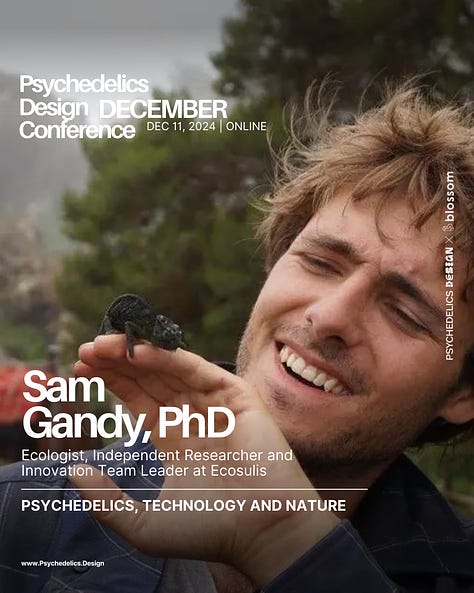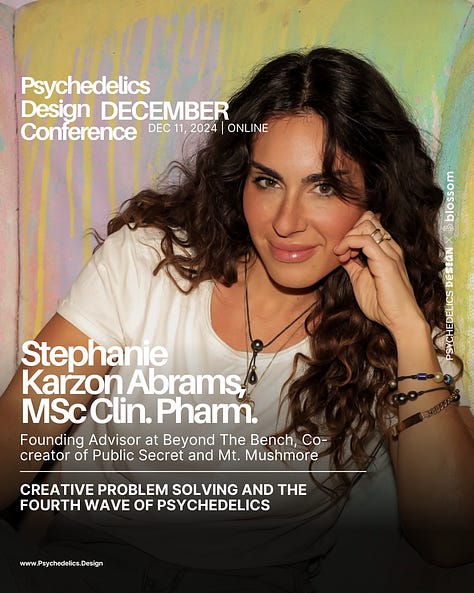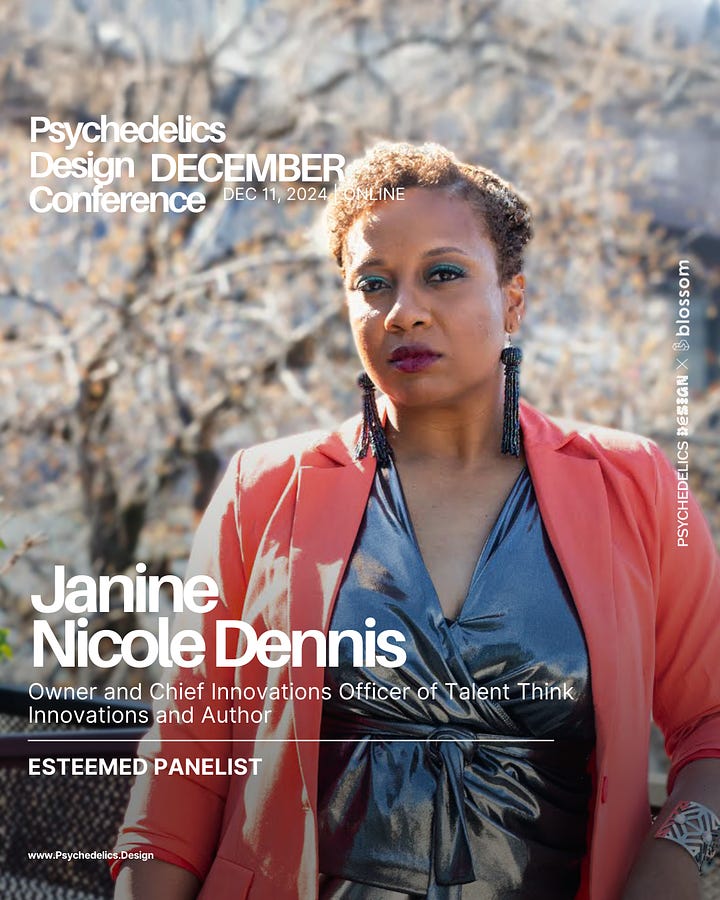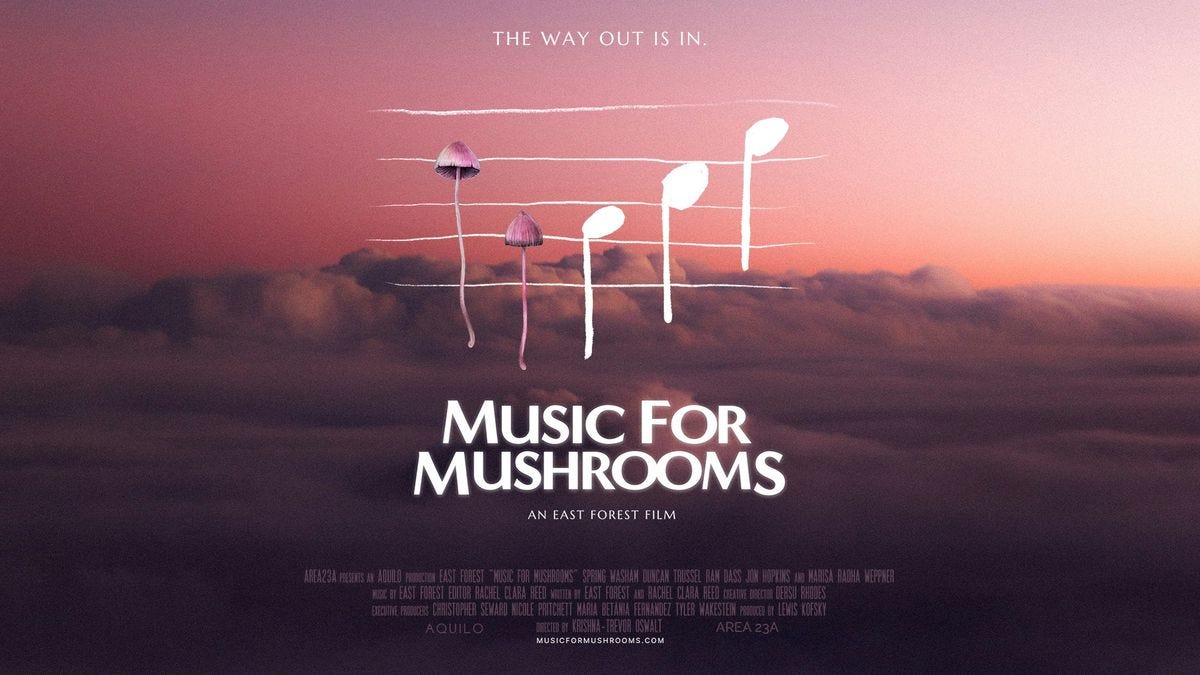Sonic Alchemy: Transforming Minds through the Magic of Music in Psychedelic Journeys
“Ultimately though, all I have to say about it is said by the sound.” – Jon Hopkins on RITUAL
At the intersection of neuroscience, design, and auditory perception lies a world of infinite possibility—a space where sound waves become tangible, and music paints vivid landscapes in the mind's eye. My creative consciousness, often labelled as neurodivergent, apparently is on the edge between synaesthesia and misophonia, which means depending on set and setting and mood of the day, a lot is going on when I listen to music.
As an artist/designer, I was always curious and exploring human cognition, I'm drawn to the alchemical potential of psychedelic therapy settings. Here, music isn't merely background noise—it's an architectural element, shaping the very fabric of consciousness. The auditory environment becomes a living, breathing entity, capable of guiding journeys through the labyrinth of the psyche.
This exploration is more than academic curiosity; it's a quest to understand the intricate interplay between sound, space, and the human mind. When starting psychedelic research and my MSc in Applied Psychology I went straight into reading about music's role in psychedelic therapy. I quickly learned about Wavepaths for example in 2022, where it felt like they have been, seeking to harness the power of auditory design to catalyze profound shifts in cognitive functioning.
In this fusion of art and science, we stand at the threshold of a new paradigm—one where the careful curation of sound becomes a tool for healing, growth, and expanded consciousness. I thought to dig up some old notes on the topic, especially inspired by Jon Hopkin’s latest release RITUAL and East Forest’s documentary Music for Mushrooms.
FROM OUR SPONSOR
Purple City Retreats is a legal premier wellness retreat experience for singles & couples. For the guest who wants privacy, we have you covered! You’ll experience a luxury getaway that offers accessibility to both metropolitan and natural spaces. Aside from our beautiful, convenient location and chic, comfortable accommodations, we offer our guests access to a unique menu of wellness services, including professionally guided psilocybin therapy.
Hear founder Michelle Harrell talking about "Cultivating Safe Spaces: Enhancing Human Potential in Regenerative Environments” at our online conference on December 11!
Please use code PURPLEFRIENDS for a 10% discount on stays and retreats at Purple City!
Music and Altered States of Consciousness
The term "psychedelic" combines the Greek words for "mind" and "to manifest," reflecting the profound experiences these substances can evoke. Music has historical importance to humans in giving meaning, expressing feelings, and potentially supporting soulful emotionality. It was a tool to guide or support experiences during the administration of psychedelics throughout time. Music is ancient. “The oldest known musical instruments appear in the archaeological record from 40,000 years ago” (Killin, 2018, p. 1).
As Kaelen et al. (2018) put it: “Psychedelics and music listening interact to produce profound alterations in emotion, mental imagery, and personal meaning. Research is beginning to unveil underlying brain mechanisms and to support a central role of music in psychedelic therapy. Music influences the efficacy of therapy significantly, through modulating emotion, including the facilitating of mystical experiences, and through supporting autobiographical processes”.
At the moment, music selection for psychedelic therapy is not standardized. Some music features may support the mystical experience and guide the patient’s journey. Research on music has begun to address music’s capacity to support altered states, such as transcendental experiences, its ability to convey and modulate emotion, and the induction of flowing states of ecstasy and hallucination!
Samorini writes in “The oldest archaeological data evidencing the relationship of Homo sapiens with psychoactive plants” about archaeology indicating the ancient global use of psychedelics, already attested during the Neolithic (around 11000 BC) period. So music as much as plant medicine has played a central role in traditional medicinal, and spiritual practice, from ceremonies of the Mazatec Indians to peyote ceremonies of Native Americans and Rites of Eleusis.
Music as part of the setting
Influencing experiences significantly, music is a vital element of the setting to support the therapeutic experience and meaning-making. Music directly influences the emotional experience within a setting and should be selected very carefully, responsibly, and attuned to the individual. And then, mind-altering substances have as much written the history of music!
“The psychedelic space needs a lot of new music that is designed for it. Otherwise, you have a playlist made of a hundred different energies. It’s like someone new coming into the room every 10 minutes and bringing their stuff into your space.” – Jon Hopkins
Beyond the mind, experiences with music arguably can have therapeutic effects, from the relief of physical pain and a positive effect on neurological disorders. It is reported that the music experience during psychedelic therapy provides a sense of safety and calm and correlates with mystical experiences and insightfulness. Music seems a supportive guide during the onset, ascent, and return phases of the psychedelic experience; but it can argumentely have the opposite effect as well. As the quality of the music experience has been associated with therapy outcomes, and, more specifically, a music experience characterized by personal ‘resonance’, the conclusion follows that the music selection requires an intelligent optimization, or maybe intuitive flow even to the individual patient.
Musician Jon Hopkins said in an interview with EDMTunes: “The psychedelic space needs a lot of new music that is designed for it. Otherwise, you have a playlist made of a hundred different energies. It’s like someone new coming into the room every 10 minutes and bringing their stuff into your space.” Is this not something every highly sensitive person can deeply resonate with? Suddenly there is a song in the playlist and everything changes drastically. Now just imagine what this does to someone going through a psychedelic journey.
A study, already mentioned earlier, with semi-structured interviews (by pioneers Mendel Kaelen, Bruna Giribaldi, Jordan Raine, Lisa Evans, Christopher Timmerman, Natalie Rodriguez, Leor Roseman, Amanda Feilding, David Nutt, and Robin Carhart-Harris) about the evidence for a central role of music in psychedelic therapy found that: “Analyses of the interviews revealed that the music had both “welcome” and “unwelcome” influences on patients’ subjective experiences. Although a strong dislike of the music selection was rare, it was associated with feelings of discomfort, irritation, and even resistance to the experience overall. But what happens to us when we listen to music?
Your brain on music
Brains are parallel processors running with a perceptual system, making sense of the information we receive through sensory receptors — the retina for vision, the eardrum for hearing. Most of the time, this information is fragmented and obscured by our environment. Our perceptual system allows us to fill in the missing information gaps through experience to help make decisions quickly.
All humans are born “with an innate capacity to understand any of the world’s languages, and that experience with a particular language shapes builds, and then ultimately prunes a complicated and interconnected network of neural circuits…our brains and natural languages coevolved so that all of the world’s languages share certain fundamental principles, and our brains can have the capacity to incorporate any of them, almost effortlessly, through mere exposure during a critical stage of neural development. Similarly, it seems that we all have an innate capacity to learn any of the world’s music” (Levitin, 2006, p. 107).
Our understanding and appreciation of music are deeply rooted in our personal experiences and the remarkable adaptability of our neural structures. As we encounter new songs or revisit familiar ones, our brains continuously learn and evolve, developing a unique musical grammar that is intimately tied to our cultural background. This process mirrors the way we acquire language, with our brains becoming attuned to the specific musical patterns and structures prevalent in our cultural environment. Through repeated exposure and active listening, we build a complex network of musical understanding that allows us to interpret and enjoy the diverse array of sounds we encounter throughout our lives.
Your brain on psychedelics
The exploration of music has offered valuable insights into the brain's organization and functioning. This is largely due to the fact that engaging with music activates extensive neural networks responsible for various cognitive processes, including attention, memory formation, motor control, and emotional processing. Furthermore, recent research has increasingly supported the concept that the level of brain entropy - a measure of the complexity and unpredictability of brain activity - correlates strongly with the depth and richness of conscious experience. This connection between brain entropy and consciousness provides a fascinating link between our neurological processes and our subjective experiences, particularly in the context of music perception and appreciation. Psychedelic drugs seem to affect our ability to receive and interpret auditory information such as music and how we emotionally react to it.
Already in 2015, Kaelen et al. wrote in “LSD enhances the emotional response to music” that LSD and music interact to increase effective connectivity from the parahippocampal cortex to the visual cortex. This ties in with an increase in visual mental imagery and autobiographical memories.
“Brain regions recruited during music listening overlap at least partially with brain regions where activity and connectivity are altered after the administration of psychedelics” (Barrett et al., 2018, pg. 3).
The synergy between music and psychedelics
In a world where sound can sculpt consciousness and music serves as a guiding light through the labyrinth of the psyche, we stand at the forefront of a revolutionary understanding of auditory experiences.
Jon Hopkins on his new album Ritual composed like an entire journey: “It feels like a tool, maybe even a machine, for opening portals within your inner world, for unlocking things that are hidden and buried. Things that are held in place by the tension in your body. It doesn’t feel like ‘an album’ therefore – more a process to go through, something that works on you. At the same time, it feels like it tells a story. Maybe it’s the story of a process I’m going through, and one that we are all going through. Maybe it’s also the story of creation, destruction and transcendence. Maybe it’s the story of the archetypal hero’s journey – the journey of forgetting and remembering.”
Music is not merely an accompaniment but a vital element in psychedelic journeys, capable of shaping emotional landscapes and enhancing therapeutic outcomes. The relationship between sound and altered states is ancient and yet we seem to only start to uncover (or re-discover) the profound potential for healing and growth that lies within carefully curated auditory environments.
MUSICAL INSPIRATION
Jon Hopkins – new album, RITUAL
Jon Hopkins’ new album RITUAL was released on August 30. RITUAL is a 41-minute ceremonial epic that unfolds over eight chapters, it is by turns devotional, empowering and nurturing. Featuring long-term collaborators Vylana, 7RAYS, Ishq, Clark, Emma Smith, Daisy Vatalaro and Cherif Hashizume, RITUAL came together within the second half of 2023, but initial seeds were sown in 2022, when Hopkins was commissioned to compose for the Dreamachine immersive experience created by Collective Act, in collaboration with a team of artists, scientists and philosophers. A project that felt ceremonial from the outset, this shorter piece was the embryo of RITUAL, with Hopkins gaining inspiration from the feeling of intention that is inherent in the Dreamachine space.
“It is a 41-minute ceremonial piece and was the most joyful and collaborative experience I’ve ever had making an album. It feels like a kinetic counterpart to Music For Psychedelic Therapy.” – Jon Hopkins
The first single RITUAL (evocation) is out now. This is really a preview, like the essence of the record, a window into the full thing. The video, starring Bryony Louise, and directed by Dave Bullivant, is drawing you in.
Stream/Purchase RITUAL: DomMart | Digital
Watch the Video for “RITUAL (evocation)”
East Forest – Music for Mushrooms
Can pairing music with psychedelics bring transformative healing to the world? Music for Mushrooms is an 82-minute narrative feature film, that follows East Forest's journey as he develops a unique approach to live performances, blending music and ceremony to create transformative experiences for attendees.
These immersive concerts provide a safe space for participants to explore their inner worlds, confront personal challenges, and reconnect with their authentic selves. The film looks deeply into the intersection of music, psychedelics, and personal growth through a series of interviews and discussions. It features insights from a diverse group of experts, including spiritual teachers, scientists, musicians, and philosophers such as Ram Dass, Xochitl Ashe, and Dr. Robin Carhart-Harris.
In theaters now. Watch the trailer and listen to the 2019 album on Spotify here
ONLINE DECEMBER CONFERENCE
Us from Blossom and Psychedelics Design would also like to take today’s newsletter as an opportunity to thank our first sponsor, Talent Think Innovations for their support, as well as our speaker partners, community partners and media alleys. A special thank also goes to SetSet who will be gifting our speakers a little surprise.








The conference will cover:
Psychedelics and Empathic Design–A Female Perspective
Cultivating Safe Spaces: Enhancing Human Potential in Regenerative Environments
Neuroplasticity & Innovation: Exploring Creative Problem-Solving in the Fourth Wave of Psychedelics
From Past to Present: What Psychedelic Care and Culture Reveal About Creativity and Design
Harmonizing Psychedelics, Technology, and Nature: Innovating Our Connection to the Earth
System Change by Psychedelics
Don't miss this opportunity to expand your perspective and get inspired already for everything that lies ahead in the new year! Tickets are just $28 (including recordings). See you there!
https://www.psychedelics.design/psychedelics-design-conference-december









